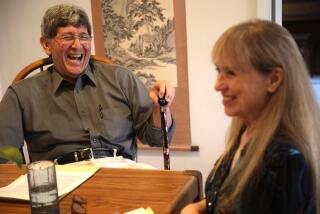Something Malignant Under California Sun : Experts ‘Alarmed’ by the Increase in Skin Cancers
- Share via
This is about people who bought the notion that “life is a beach,” but now realize how badly they got burned.
It’s about the fact that on these radiant spring days, as thousands of folks sprawl on the sand catching rays, dozens of others are sitting in dermatologists’ offices, waiting to be treated for skin cancer. It’s about the growing number of people who are finding out that the Southern California coast, long known as the realm of the mellow, is also the realm of melanoma--the most serious form of this sun-related disease. In fact, UC Irvine Medical Center (UCIMC) today is opening a Melanoma Center to deal with what many experts are calling “an epidemic.”
What’s sadly ironic is that people with skin cancer usually seem so robust.
Take Eva Ljungwe (pronounced Young-va), a 29-year-old chemist from Laguna Hills. A dedicated runner and bicyclist, Ljungwe is the sort of woman Outside magazine might put on its cover to illustrate the vitality of California’s healthy way of life.
Started as a Small Bump
Her eyes are the color of the sky on mornings when the Santa Anas have been blowing. Her personality might be described as sunny.
Three years ago, however, a small, colorless bump appeared on Ljungwe’s neck. It was diagnosed as malignant melanoma. Cancer spread into Ljungwe’s body through her bloodstream. Now the disease is steadily changing her life, and may claim it completely. “I still have a lot of denial. I still can’t believe it’s happening to me. . . . But I think my chances for living another five years are really remote,” she said.
Most Common Cancer
Each year, about 500,000 people in the United States walk out of doctors’ offices pondering the news that they have non-melanoma skin cancer, according to the Skin Cancer Foundation in New York, a nonprofit organization that compiles data on skin cancer. This represents a 15% to 20% increase in the past 15 years. According to the American Cancer Society, the disease is the most common form of cancer in humans. But “it’s also one of the most curable--and preventable--forms of (cancer),” society literature points out.
If diagnosed promptly, most types of skin cancer are easily arrested, dermatologists say. However, the American Cancer Society predicts about 23,000 new cases of malignant melanoma--and 5,600 deaths from the disease--this year.
The Skin Cancer Foundation calls the rate at which malignant melanoma is increasing in the United States “alarming.” In 1930, an individual’s lifetime risk for getting melanoma was one in 1,500; in 1950 it was one in 600, and the foundation predicts that if the trend continues, by the year 2000 nearly one in 100 Americans will develop the disease, which usually announces itself in the form of small, brown-black or multicolored patches or nodules with irregular outlines, and often develops in pre-existing moles.
Studies have shown that incidence of melanoma is twice as high in Sun Belt areas as in the country at large. UCLA Medical Center’s John Wayne surgical oncology clinic--one of the few clinics in the country with melanoma treatment and research as a specialty--takes a multi-discipline approach to melanoma, generally after patients have been diagnosed and referred by a dermatologist; and USC specializes in melanoma research at it’s Norris Cancer Center. The center opening today at UCIMC will offer “state of the art diagnosis, treatment and research,” according to Dr. Ronald Barr, an associate professor of dermatology and one of seven doctors in the center’s “core group.”
Graphic Evidence
At the same time, Barr and others will continue seeing the patients who pass through UCIMC’s twice-weekly dermatology clinic to be treated for other forms of skin cancer.
One patient undergoing treatment at the UCI clinic recently offered graphic evidence of the different forms the disease takes. The man, who asked that his name not be used, had arrived in California when he was 5. But his fair complexion was clearly not designed for this Golden State. Now, at age 72, his skin shows the effects of a lifelong battle with sunlight.
Turning the patient’s hands, Barr pointed out the results of “chronic skin damage”--scaly red and white patches of pre-cancerous skin called solar keratoses and areas of solar elastosis, where the skin had yellowed and wrinkled.
The two most common types of skin cancer are basal cell carcinoma and squamous cell carcinoma, and the patient has had bouts with both, Barr said.
Squamous cell cancer, such as the man had on his hands, usually starts as red patches or nodules, tends to grow slowly, and may ulcerate like a persistent sore as it spreads, Barr explained. Prognosis is usually very good, he added.
Basal cell cancer usually starts out as a small pearly bump or nodule on the head, neck or hand, and may display a fine network of small blood vessels, Barr said. Basal cell cancer also spreads slowly, and if diagnosed early, is usually fairly easy to control.
Waited Too Long
The patient being treated at the clinic, however, had clearly waited too long. The basal cell cancer had eaten away one side of his nose and what was left was rimmed with a crusty red and black scab. “They’re sometimes called rodent ulcers, because they look like the damage rodents used to cause on corpses that were left on slabs,” Barr said.
The skin cancer that is the most difficult to treat, however, is melanoma.
“Melanoma is a very unusual and bizarre disease,” explained Dr. Alan Wile, a UCI surgical oncologist on the staff of the new melanoma center. “It can be a very, very benign cancer, or, if ignored or unrecognized, it can be a very, very aggressive cancer.
“Part of the problem in dealing with melanoma is that although it’s very common, there are very few centers which deal with it to the point where they can gain real expertise. . . . What we would like to see here are not only the simple (cases), or the medium complex things, but the very complex things, so that we can begin to study these in an intelligent fashion.”
Surgeons will generally remove much less tissue in melanoma operations than they did 30 years ago, but surgery is still the best way to arrest the disease, Wile said. Melanoma tends to grow in a “radial phase,” spreading laterally within the epidermis (the outer layer) of the skin, and then in a vertical phase, penetrating deeper into the dermis and perhaps into tissue beneath the dermis, Wile said, and so melanomas “have to be removed much more widely than you would expect, because they have little tentacles that reach out farther than is apparent to the eye.”
” . . . In a couple hours I’m going to operate on a man who had something on his cheek. He let it go, and now he has a very thick melanoma. His prognosis is not very good,” Wile said. “The whole scenario for this man would have been changed had he or his physicians or his family members been aware of what a melanoma is.”
Better yet, the man might have known how to prevent the disease, Wile said, pointing out that the evidence linking overexposure to ultraviolet light with every form of skin cancer is now overwhelming.
“The sun does two things. It has a direct effect, damaging the skin cells,” Barr said, adding that certain experiments have shown that sun exposure may also decrease the immune system’s ability to protect the body from skin cancer.
Harvard Study Released
The most recent exhibit in medicine’s ongoing trial of the sun is a study released last month by a Harvard Medical School dermatologist that suggests people who got sunburned so badly that their skin blistered even once before the age of 20 doubled their chances of developing a malignant melanoma.
Because the effects of sun exposure are cumulative, they naturally show up most frequently in older people, Barr said. But he and his colleagues are seeing an increasing number of skin cancers, including malignant melanoma, in young people, he added. “It seems to be becoming more common. . . . If I find a melanoma in an 18-year-old now, I’m not surprised.”
As advice on how to avoid melanoma, Barr held up an American Cancer Society pamphlet promoting the slogan “Slip, Slap, Slop.” That means, slip on a shirt, slap on a hat, slop on a protective sunscreen with a Sun Protection Factor (SPF) of 15 or better, Barr said, adding that dermatologists also recommend avoiding tanning studios.
Even when preventive measures are taken, though, Barr suggests that people--especially those who are fair-skinned or burn easily and those with a family history of melanoma--keep their eyes open for warning signs. At least once a month people should get together with someone or use a mirror to systematically go over every inch of their bodies, examining every pigmented mole and birthmark for any change in size, color, shape or texture, Barr said. “And people who have multiple, large, atypical moles, should see a dermatologist routinely.”
Travels in Bloodstream
Eva Ljungwe was 26 when surgeons at UCLA Medical Center removed the first bump that appeared on her neck, along with the surrounding lymph nodes. A year-and-a-half later another bump appeared in the same area. A few months after that was removed, a third clear nodule appeared on her back. At that point, doctors knew that the cancer was traveling through her bloodstream.
Ljungwe doesn’t talk much about her cancer, she said--partly because she doesn’t want to burden people, but also because she knows the disease has such a potent image that it becomes a label: “Eva the great chemist becomes Eva the one who has cancer.”
Still, “a day doesn’t go by that I don’t think about it,” she said. “The disease is really escalating now. There is no time that I’m not on one kind of therapy or another. There’s no time that I’m not missing work now and then.” And, she said, the pain is getting worse. “Pain is hard to describe. . . . It just hurts. I’ve always had twice as much energy as everyone else, now I’m sort of coming down to par. Now it takes an awful lot of self-discipline to go out and do things.”
But when she does get out--to go backpacking in the Sierra, or bicycling or walking on the beach at sunset--she is more acutely aware of being alive. “Especially when I’m out in nature. I say, damn it, I’m alive! I see a lot more beauty than I ever felt before.”
Since she refuses to let fear control her own life, Ljungwe has no intention of recommending that others hide themselves in dank cellars to avoid all exposure to sunlight or do anything else to eliminate all risk from this risky world, she said.
She is, however, a firm believer in moderation--and in sunscreen. And despite her obvious aversion to preaching, she has a succinct message for her fellow lovers of the great outdoors: “Be aware of what’s going on with your skin.”






